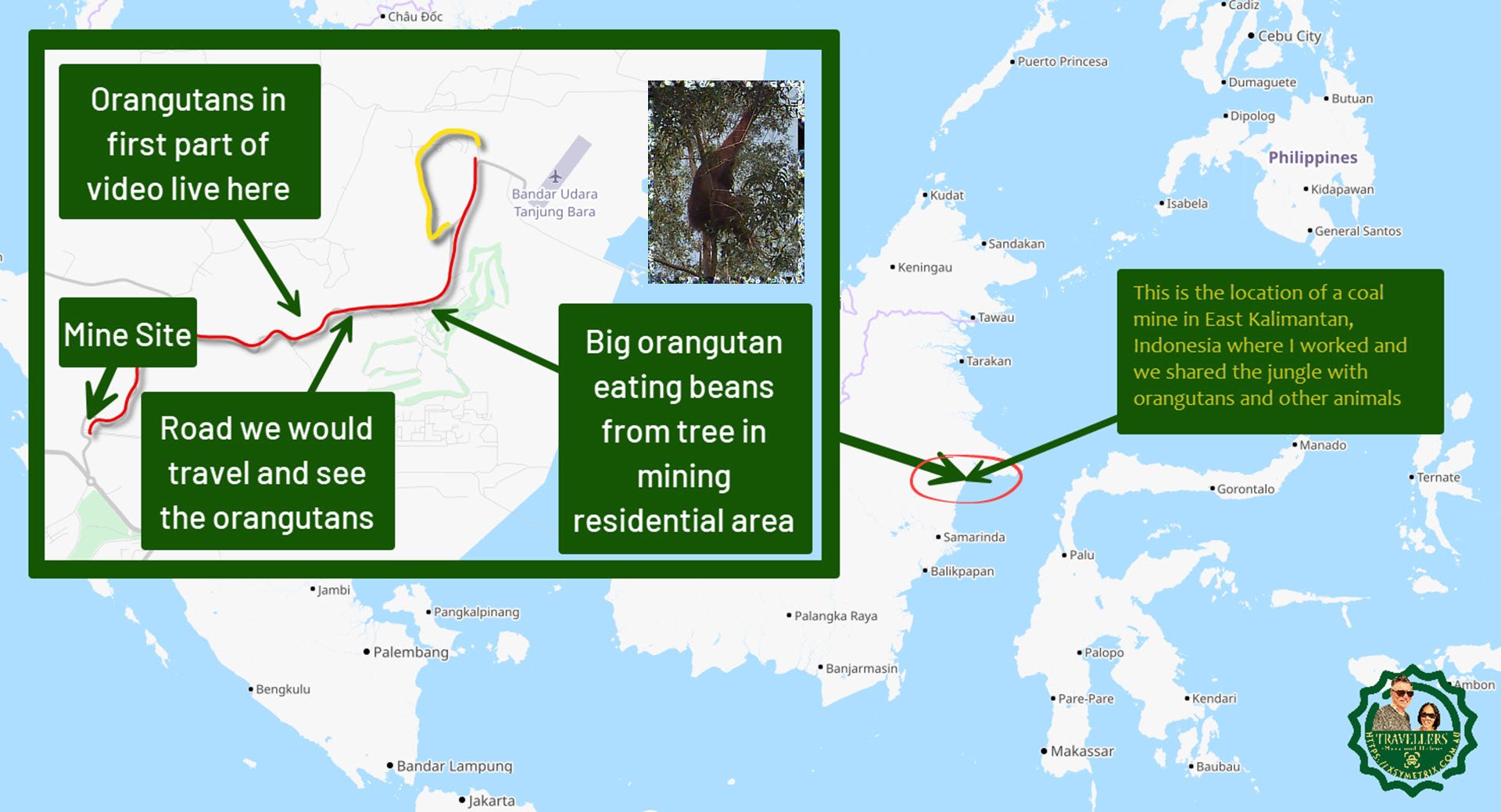Wild Orangutans in East Kalimantan

In 1998 I was fortunate enough to be working in East Kalimantan. I was working for a coal mine implementing a multimedia learning system in the heart of the jungle. The area is home to people from Dayak tribes and many years earlier in 1986, I had spent time in a remote village in the same province as part of a cultural exchange with the Department of Foreign Affairs.
During my time there on both trips, I saw many amazing things. There were seams of coal in the ground that had been burning for many many years. To walk into the jungle with a geologist who pointed out these terrifying walls of flame that continued to burn is something I’ll never forget. Probably started by a lightning strike many years previously, these ghostly burning seams of coal could stoke the imaginations of superstitious villagers with deep-rooted beliefs in animism.
On a journey further into the centre of Kalimantan, as we travelled deeper inland up the Mahakam River from our village on the banks of Lake Jempang, I remember seeing acres and acres of wild orchids, including the famous black orchid, growing in the forest in the trees and up out of the sand.
This hidden natural gem of majesty is hundreds of kilometres inland of the East Kalimantan province along the edge of the Mahakam River. The place we visited back then was known by its Indonesian name Taman Anggrek.
Back in the village of Tanjung Isuy, generator-driven electricity was available for two hours in the evening. This was enough to provide electric lights and power for the television that broadcast news during this dinner time. In the evenings we conducted lessons to teach those who could read some of the letters of the alphabet. Not being a teacher I learnt a couple of lessons myself.
It was mainly the women of the village, the mums and grandmothers who had not had the chance to attend school who came down to these evening classes. These ladies would make their way down to the classroom holding kerosine lanterns as the generator was turned off by the time we conducted these lessons. They would almost all have white powder on their face that was talcum powder mixed with water. Combined with the flickering light from the kerosine lamps on these white-painted faces emerging from the jungle darkness, they looked like ghostly apparitions as they glided into the classroom.
The reality of poor light and no access to reading glasses was a reality check that meant that I had to write letters almost 60cm high on the blackboard to make sure the ladies at the back could see. I still remember the first sentence I wrote in these large letters… Ini topi Ali (This is Ali’s hat). Don’t know white I wrote it – maybe I was looking for small words. If I had my time again so much would be different.
Fast forward 12 years to the Kaltim Prima Coal site, located about 350km northeast of the village of Tanjung Isuy. This is where this short tale about my encounter with orangutans in the wild takes place.
In 1998 I was just starting to move into the world of digital photography and the video camera that I had produced small mpeg videos of 384 pixels wide. The GOPRO I currently use captures video that is 3800 pixels wide. So the video that you see can’t really be made any larger for a normal HD screen.
While the footage is not the best it captures wild orangutans in the jungle living in the vicinity of the mine site where I worked.
Wildfires had burnt out a lot of the forest and jungle which in turn had driven many of its inhabitants to any location that had food. The residential areas of the mine site were watered and were lush and green. Of course, there was fire protection there so nothing was burnt. People were careful not to feed animals in a way that they became dependent however occasionally the odd bunch of bananas would be left and thankfully received.
The orangutans look incredibly cute but if threatened can be very dangerous and can kill you. 2 other kinds of monkeys that we saw frequently were the proboscis monkeys who look quite strange with their bulbous noses and the more fearsome macaque monkeys who travelled in packs and would come and raid the rubbish tins in the campsite. I did spend a period locked in my room when a troop of macaque monkeys decided they were going to take control of the single quarters where I had my room. The fangs on the big male would have left and nasty bite.
I just want to talk about 2 of these orangutans firstly the female orangutan eating bananas. We saw her on a few occasions and one occasion while we were driving to the mine site from our accommodation she was sitting in the middle of the road. We were worried that a vehicle might come along and run her over. Dave pulled over to the side of the road and I opened my window and gestured to the orangutan as if to say get off the road. In a response that I’ll never forget the orangutan looked at me and flicked her hand back at me mimicking my action, basically telling me to get off the road. It was probably the most human thing that I’ve seen a primate do.
Orangutans build nests in trees to sleep and if you get too close to the nest you will hear threatening sounds and then potentially a stick may be thrown your way to suggest that you should move on.
Another event I saw and didn’t film because it was pouring rain was a male orangutan who was sitting under a tree in the rain holding a large jungle leaf over his head in an attempt to keep the rain off him. So using the leaf as an umbrella.
I think it was the same male orangutan that I did capture a video of and I’m going to talk about now.
One day when we were going down to the commissary which is another name for the small shop where we bought our provisions, there were a few people gathered around a large tree in front of the shop entrance. In looking up I saw a very large male orangutan who was feasting on the beans or rather the bean pods of that tree. He would grab these beans which look a little bit like a snow pea and put them in one side of his mouth and the husk would come out the other side and drop down to the ground and the peas would end up in his stomach. The speed precision and consistency that the orangutan used to consume these beans was amazing and you can see from the video the large pile of discarded pods that were left at the base of the tree.
I have to call him Chewbacca because I filmed him eating those bean pods on May the 4th, 1998.
To have been able to witness and experience orangutans in the wild is similar to the experience I had swimming with wild sea lions in the Galapagos Islands. A chance encounter probably forgotten by the animals, not knowing that they have created a memory for me that lasts forever.
These two memories, one almost 40 years ago and the other more than 25 years ago are still special for me, which is why I wanted to share them when I discovered these videos in the archive.
I only hope that future generations will also have a chance to see these animals in the wild and not just in a zoo.
This blog post is dedicated to Dave Olive who invited me into the jungles of East Kalimantan and introduced me to adventures and experiences like this.


One Response
[…] The last one – Chichen Itza on the Yucatan Peninsula in Mexico is so close to where we are visiting in the Caribbean, it makes sense to tick off the last of the new wonders. It will come after I hopefully get to witness a sloth in the wild in Costa Rica, as I have done with oranghutans in the East Kalimantan jungles. […]